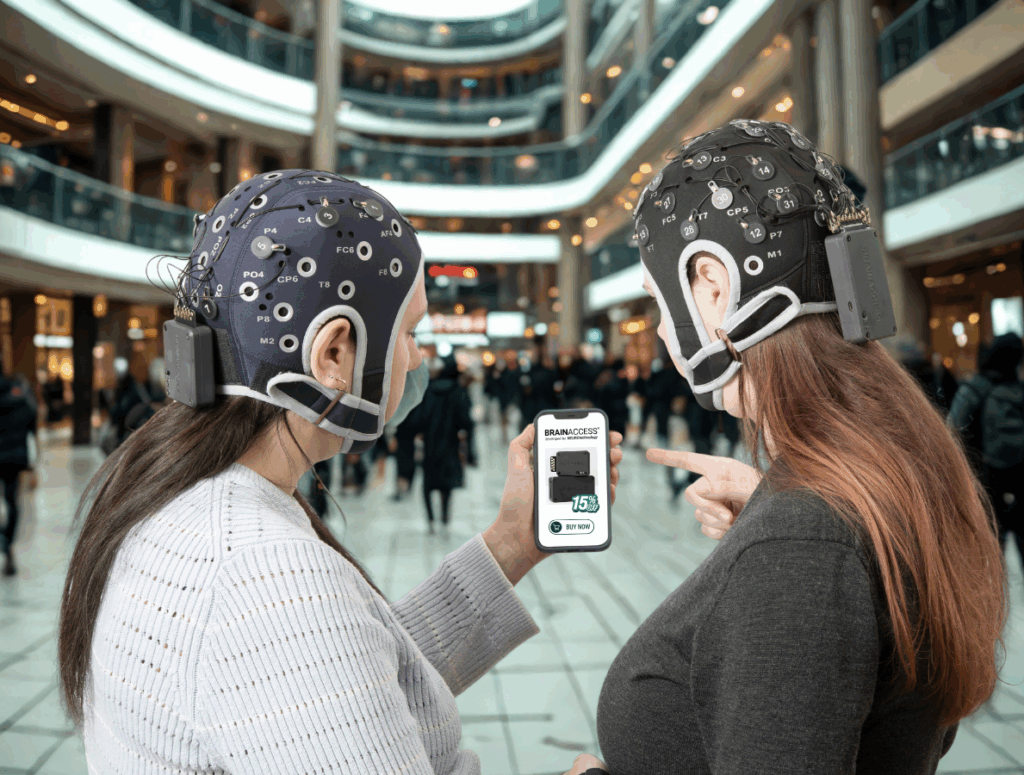Black Friday and Cyber Monday bombard shoppers with irresistible discounts, triggering a flurry of neural activity as we decide whether to purchase that deal or not.
Electroencephalography (EEG) records brain waves in real time, offering unique insight into these rapid-fire consumer responses. In fact, EEG studies show that the sight of a bargain immediately engages brain reward circuits and attention networks, reflecting processes of value evaluation, emotional arousal, and decision-making within fractions of a second.
Below, we explore what neuroscientists have learned about the consumer brain on “sale fever” and how this knowledge is opening new frontiers in Neuromarketing.
EEG Markers of Consumer’s Response to Sales
Deep in the brain’s reward center, a good bargain (or sale tag) can spark a burst of dopamine, the neurotransmitter of pleasure and desire. Functional imaging has shown that seeing a price we perceive as a great deal activates the nucleus accumbens, a key reward hub. The dopamine released not only makes us feel happy about the potential purchase, but also increases impulsivity, contributing to that “I need to have it now!” urge when a limited-time sale appears.
EEG, with its millisecond precision, can catch the cortex’s response to this dopamine surge. For instance, event-related potential (ERP) studies find that when a product’s price is unexpectedly low (better than we predicted), the brain generates a distinct positive-going signal around 250-300ms. This signal corresponds to the feedback-related negativity (FRN), essentially the brain saying “good surprise!”, which becomes less negative (or more positive) for an unexpectedly good deal (Schaefer et al., 2016). Specifically, in one virtual shopping experiment, both the FRN and a later P300 wave were amplified when participants were offered prices cheaper than expected, and importantly, these EEG responses predicted whether they would decide to buy the product (Schafer et al., 2016). In other words, a big positive prediction error (a much better price than anticipated) elicited a reward-related brain response that often translated into a purchase decision.
This finding aligns with reinforcement learning models: a surprise bargain is a positive prediction error that engages reward circuitry and the anterior cingulate cortex (ACC), generating a burst of mid-frontal theta-band activity, to update our decision and encourage the “buy” action (Schaefer et al., 2016).
Dopamine rush plays a crucial role in determine consumer’s behavior, but which other cognitive functions comes into play and which biomarkers can we use to study them?
Attention & Early Evaluation: the P200 component
Within ~200 milliseconds of seeing a discount label or price drop, the visual cortex and frontal lobes fire off signatures of attention and early evaluation. Researchers have observed a P200 ERP component as early as 160-210 ms when a product is shown with a discount tag, indicating automatic attention to the discount (Pšurný et al., 2024).
Intriguingly, the P200 was smaller in amplitude for products that had a discount or “sale” badge next to them, compared to the same products without such cues (Pšurný et al., 2024). A reduced P200 suggests the brain processed the discount cue more efficiently and with a positive bias. In essence, participants’ brains grabbed the discount information peripherally (even before their eyes focused on it) and rapidly flagged it as important, requiring less effort to process than the product itself.
Such lightning-fast processing implies that sale cues hijack our attention pre-consciously. While shopping, our brain can register “50% OFF” in the visual periphery and start valuing the deal before we even fully look at it!
Salience & Subjective Value: the P300 component
Following these initial signals, the P300 component (appearing ~300ms post-stimulus) emerges, reflecting evaluation and subjective value assignment. The P300 is a well-known index of attentional resource allocation and salience detection in the brain’s decision-making process.
During Black Friday scenarios, a steep discount or a flash sale item often elicits a larger P300, signifying that the brain tags it as noteworthy (“this is important, pay attention”). Notably, individual differences in price-processing can be seen here: consumers who are less numerically savvy (low numeracy) show smaller P300 amplitudes when judging discounts, suggesting they allocate fewer cognitive resources to parsing the deal (Huang et al., 2022). By contrast, high-numeracy shoppers produce a stronger P300 a sign that they’re actively crunching the numbers and fully appreciating the value on offer (Huang et al., 2022).
In practical terms, the P300 is larger when a deal “stands out” or violates expectations, and this neural marker correlates with greater likelihood of the consumer acting on the bargain.
Think of it as if the brain’s “attention spotlight” shines brighter on prices that feel like big savings!
Emotion & Motivation: the LPP (late positive potential)
As the decision window unfolds, later EEG components capture the emotional and motivational weight of the choice. Around 500-700 ms after seeing a product and its price, the late positive potential (LPP) appears.
The LPP is a sustained positive wave associated with emotional arousal and significance. Emotionally charged or personally relevant stimuli (for example, a coveted item on sale) tend to amplify LPP amplitude relative to neutral stimuli (Schupp et al, 2004).
In a shopping context, if a discount provokes excitement or joy (common with hedonic purchases like a flashy gadget or luxury handbag on clearance), one can expect a higher LPP, reflecting that the consumer’s emotional brain is engaged by the prospect of reward. Indeed, one EEG study found that discounts on hedonic products elicited more frequent emotional responses (even dilated pupils, indicating arousal) and higher LPP. Pozharliev et al., 2015).
On the other hand, utilitarian purchases (practical items) paired with certain information like a reassuring positive review can actually dampen the LPP, suggesting a calming effect (perhaps due to increased sense of security) and thus less emotional arousal.
In sum, the LPP serves as a barometer of how emotionally “invested” the consumer is: a big spike means the deal resonates on an affective level (the thrill or the joy of the bargain), whereas a smaller LPP means the decision is more cool-headed.
Arousal and Decision: Theta and Beta Oscillations
Beyond discrete ERP peaks, EEG oscillations provide another window into consumer decision processes during sales. Different frequency bands correspond to various cognitive and emotional states.
- Theta waves (approximately 4–7 Hz) in the frontal midline often ramp up when the brain detects a conflict or a prediction error, essentially when things are better or worse than expected and we must adjust our thinking. In shopping terms, a price that deviates from expectation (say, a surprisingly cheap deal or an unexpectedly high cost) triggers frontal theta activity as the brain computes the “error” and updates the perceived value. (Schaefer et al., 2016)
- Beta waves (13–30 Hz) have emerged as markers of active engagement and reward processing in consumer neuroscience. Recent work employing deep learning on EEG data identified beta-band signals as especially informative for predicting how much a person is willing to pay for a product (Hakim et al., 2023). In that study, oscillations peaking around 14–23 Hz (mid-beta) across the scalp carried key information about the consumer’s value assessment of an item. Moreover, beta activity, particularly in frontoparietal regions, has been associated with approach motivation and emotional arousal. For example, when a shopper gets excited about a flash deal, one might observe beta-band desynchronization (a drop in power) in sensory areas coupled with beta increases in decision-related circuits. This pattern is linked to heightened arousal and attention focusing (Schubring and Schupp, 2019).
In sum, a doorbuster sale not only grabs our eyes, it literally changes the oscillatory state of our brain, pushing it into a focused, aroused mode optimized for decision-making under excitement.
From Lab to Real World: Neuromarketing Applications and BrainAccess
Understanding these neural patterns has direct applications in neuromarketing, where companies seek to craft marketing strategies that resonate with the brain’s implicit responses.
EEG provides an objective measure of what captures consumers’ attention and reward response, often revealing truths that surveys and focus groups miss.
For example, subtle differences in ad design or pricing strategy can be A/B tested with EEG:
- Do shoppers’ brains show a bigger P300 when the discount is framed as “50% off” versus “Buy 1 Get 1”?
- Does a limited-time countdown timer induce the desired arousal (indexed by beta/alpha changes and LPP) or does it cause anxiety that could backfire?
By tapping into these brain signals, marketers can optimize campaigns to truly engage, aligning promotions with the neural drivers of buying behavior.
Crucially, the latest EEG technology is breaking out of the lab and into real-world retail environments. BrainAccess, a lightweight, portable, AI-integrated EEG solution, exemplifies this new generation of tools. Instead of gel-capped electrodes and controlled labs, BrainAccess offers a wearable headset that shoppers could don while browsing in a store or on a website, with AI algorithms instantly interpreting their brainwaves. This mobility and real-time analytics mean researchers and UX designers can measure natural consumer brain responses in the wild – during Black Friday mall rushes or while a person scrolls through Cyber Monday deals at home. The benefit of such a system is twofold: it captures data in the ecologically valid context (where decisions are genuine, stakes are real) and it leverages AI to quickly flag patterns of interest (e.g., a spike in theta and a positive FRN when a customer sees an unexpectedly cheap offer, indicating delight).
BrainAccess and similar devices bridge the gap between neuroscience and practical marketing, allowing continuous improvement of shopping experiences based on neural feedback. As one study noted, combining portable neurotech like EEG and functional near-infrared spectroscopy (fNIRS) with machine learning could dramatically improve our ability to predict consumer behavior, bringing neuroscience out of the lab and into business strategy.

Conclusion
In conclusion, EEG research reveals that when we hunt for Black Friday or Cyber Monday deals, our brains are performing a remarkable tightrope walk between emotional excitement and rational evaluation. Bursts of neural joy (dopamine-driven signals of reward) mix with spikes of attention and oscillations of cognitive control, all culminating in that split-second decision to buy or not. By leveraging these neural signatures neuromarketing stands to gain an unprecedented understanding of consumer cognition. And with advanced, portable EEG technology at our fingertips, we are on the cusp of translating lab insights into real-world impact, ultimately creating shopping experiences that satisfy consumers’ brains as much as their budgets.
Reference
Schaefer, A., Buratto, L. G., Goto, N., & Brotherhood, E. V. (2016). The feedback-related negativity and the P300 brain potential are sensitive to price expectation violations in a virtual shopping task. PloS one, 11(9), e0163150.
Pšurný, M., Mokrý, S., & Stavkova, J. (2024). Exploring consumers’ perceptions of online purchase decision factors: electroencephalography and eye-tracking evidence. Frontiers in Human Neuroscience, 18, 1411685.
Huang, B., Liu, X., Wang, Y., Li, H., Si, J., Wang, D., & Afzal, K. (2022). Is the discount really favorable? The effect of numeracy on price magnitude judgment: Evidence from electroencephalography. Frontiers in Neuroscience, 16, 817450.
Schupp, H., Cuthbert, B., Bradley, M., Hillman, C., Hamm, A., & Lang, P. (2004). Brain processes in emotional perception: Motivated attention. Cognition and emotion, 18(5), 593-611.
Pozharliev, R., Verbeke, W. J. M. I., Van Strien, J. W., and Bagozzi, R. P. (2015). Merely being with you increases my attention to luxury products: using EEG to understand consumers’ emotional experience with luxury branded products. J. Mark. Res. 52, 546–558. doi: 10.1509/jmr.13.0560
Hakim, A., Golan, I., Yefet, S., & Levy, D. J. (2023). DeePay: Deep learning decodes EEG to predict consumer’s willingness to pay for neuromarketing. Frontiers in Human Neuroscience, 17, 1153413.
Schubring, D., & Schupp, H. T. (2019). Affective picture processing: Alpha‐and lower beta‐band desynchronization reflects emotional arousal. Psychophysiology, 56(8), e13386.

Written by Martina Berto, Research Engineer & Neuroscientist for BrainAccess at Neurotechnology

